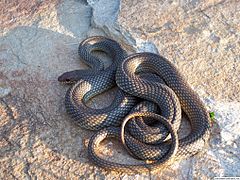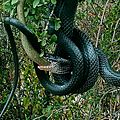Colubrid facts for kids
Quick facts for kids Colubrids |
|
|---|---|
 |
|
| Caspian whipsnake Coluber (Dolichophis) caspius |
|
| Scientific classification | |
| Kingdom: | |
| Subphylum: | |
| Class: | |
| Subclass: | |
| Superorder: | |
| Order: | |
| Infraorder: | |
| Family: |
Colubridae
|
A colubrid is a type of snake. The word "colubrid" comes from the Latin word coluber, which means snake. These snakes belong to the Colubridae family.
Colubridae is the biggest snake family. It includes about two-thirds of all the snake species known today. However, colubrids are not all closely related to each other. This family has often been a "dumping ground" for snakes that didn't fit into other groups. This means that some colubrids are actually more closely related to other snake families, like elapids, than to other colubrids.
What are Colubrids Like?
A colubrid's body is almost completely covered in scales. Most colubrids are not venomous. This means they are usually harmless to humans.
However, a few types of colubrids can be dangerous. For example, some snakes in the Boiga group can give bites that need medical help. Also, the Boomslang and African twig snake have caused deaths in people.
If a colubrid is venomous, its fangs are usually at the back of its mouth. This is different from vipers and elapids, which have their venom-injecting fangs at the front.
Famous Colubrid Snakes
Many different kinds of snakes are part of the colubrid family. Here are some well-known examples:
- Boomslang
- Brown tree snake
- Dice snake
- Garter snake
- Kingsnake
- Rat snake
- Smooth snake
- Water snake
- Mussurana
Images for kids
-
A colubrine, Dolichophis jugularis, preying on a legless lizard, a scheltopusik
See also
 In Spanish: Colubridae para niños
In Spanish: Colubridae para niños





